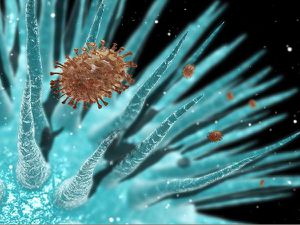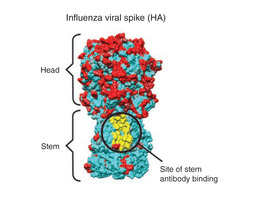Influenza Vaccine: Difference between revisions
| Line 5: | Line 5: | ||
But, the influenza virus is a rapidly evolving pathogen. The virus evolves enough from season to season that a new dose of | But, the influenza virus is a rapidly evolving pathogen. The virus evolves enough from season to season that a new dose of a modified vaccine is necessary every year, as last year's antibodies usually can not recognize this year's strain. <b>See antigenic drift section.</b><br><br> | ||
Each year's flu vaccine is a mixture | Each year's flu vaccine is a mixture, or cocktail, of vaccines for several different strains (generally 3 or 4) of the virus that the World Health Organization scientists predict will spread during that year's flu season. The predictions generally match common strains closely enough that the vaccine is fairly effective, but this is not always the case. Sometimes, a year's most common strains are unexpected ones. | ||
[[Image:Influenzafigure200.jpg|thumb|300px|right|Electron micrograph of the Inflenza virus. This shows the virus (brown) invading cilia (blue) in the airway of a human lung. http://science.nationalgeographic.com/science/photos/influenza/]] | [[Image:Influenzafigure200.jpg|thumb|300px|right|Electron micrograph of the Inflenza virus. This shows the virus (brown) invading cilia (blue) in the airway of a human lung. http://science.nationalgeographic.com/science/photos/influenza/]] | ||
Revision as of 23:33, 7 November 2013
Introduction
The influenza vaccine is a highly controversial vaccine, and has several unique qualities that make it an especially interesting topic of research.
Vaccines work by exposing the body to the right antibodies to fight a particular disease. Vaccines mimic natural infections and initiate an immune response.(more about how vaccines work)
But, the influenza virus is a rapidly evolving pathogen. The virus evolves enough from season to season that a new dose of a modified vaccine is necessary every year, as last year's antibodies usually can not recognize this year's strain. See antigenic drift section.
Each year's flu vaccine is a mixture, or cocktail, of vaccines for several different strains (generally 3 or 4) of the virus that the World Health Organization scientists predict will spread during that year's flu season. The predictions generally match common strains closely enough that the vaccine is fairly effective, but this is not always the case. Sometimes, a year's most common strains are unexpected ones.

Other examples:
Bold
Italic
Subscript: H2O
Superscript: Fe3+
Antigenic drift and new vaccine targets
Surface proteins hemagglutinin and neuraminidase are two antigens that are key players in the evolution of the influenza virus. The hemagglutinin protein helps the virus bind to and enter host cells, while the neuraminidase enzyme enables the virus to be released form the host cell as well as helps generate progeny viruses. Both proteins have specific sites that are recognized by the immune systems of the host, so these sites are under strong selection pressure. Virons with mutations in either of these proteins that allow the virus to evade attack by common antibodies are selected for by natural selection. These "fit" mutants spread to new people, and new strains evolve. This process is known as antigenic drift.
Mutations occur quite often in the RNA virus as the virus' RNA polymerase lacks a proofreading mechanism. An example of one of these mutations relates to the location of carbohydrate chains on the surface of hemagglutinin. If a mutation leads to the virus having an additional carbohydrate where the antibody binds, the antibody will no longer be effective.
The current vaccines produce antibodies that recognize a protein on the outer coating of the virus called hemagglutinin, focusing on the "head" region of the molecule (see figure 2). But this "head" region is a part of the virus that is very susceptible to antigenic drift. Thus, many scientists suspect that highly conserved molecules in the influenza virus could be used as targets for a new vaccine. This vaccine would be universal, and would not need to be reformulated and re-administered every year. Possible targets include the hemagglutinen stem, which is nearly identical across a wide range of strains, or the M2 viral membrane.

Section 2
Include some current research, with a second image.
Conclusion
Overall text length should be at least 1,000 words (before counting references), with at least 2 images. Include at least 5 references under Reference section.
References
Goodsell, David. "Hemagglutinin." RCSB.org/pdb. RCSB Protein Data Bank, 2013. Web. 07 Nov. 2013.
Edited by [Author Name], student of Joan Slonczewski for BIOL 116 Information in Living Systems, 2013, Kenyon College.
